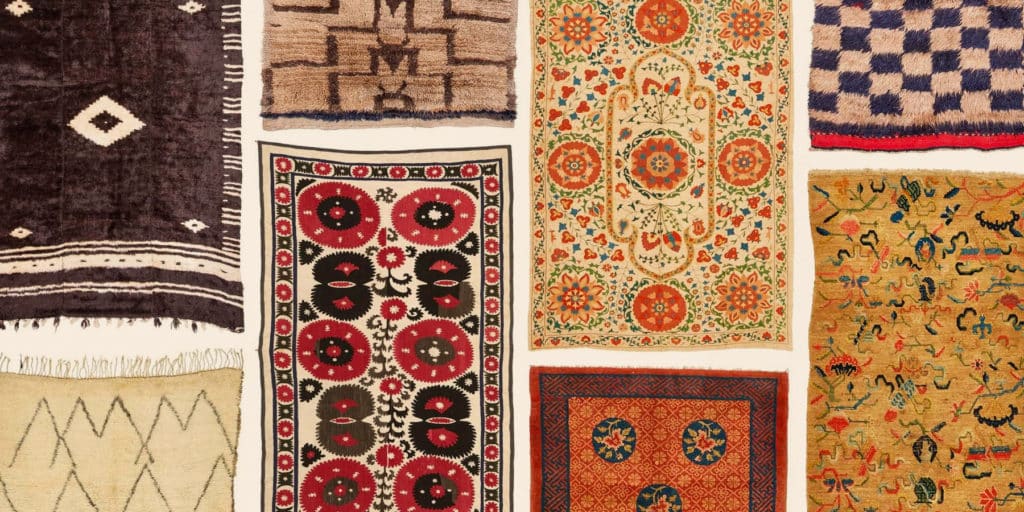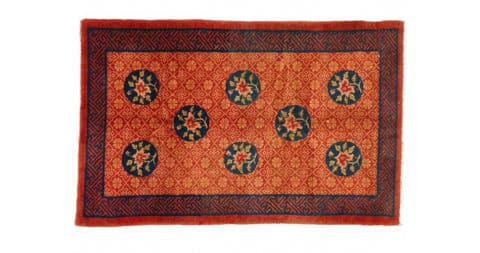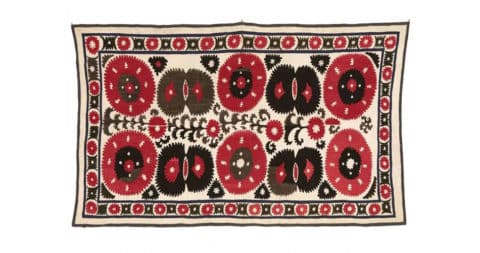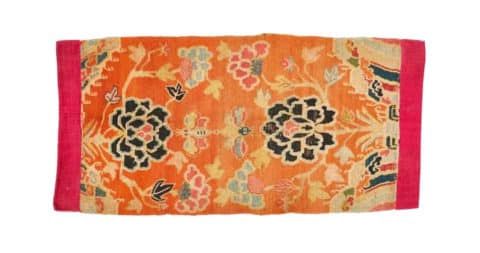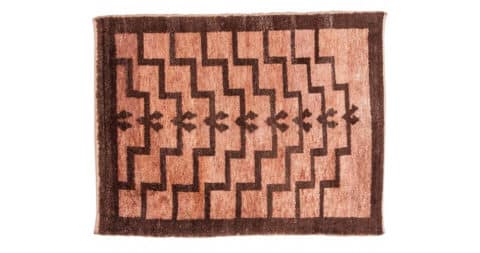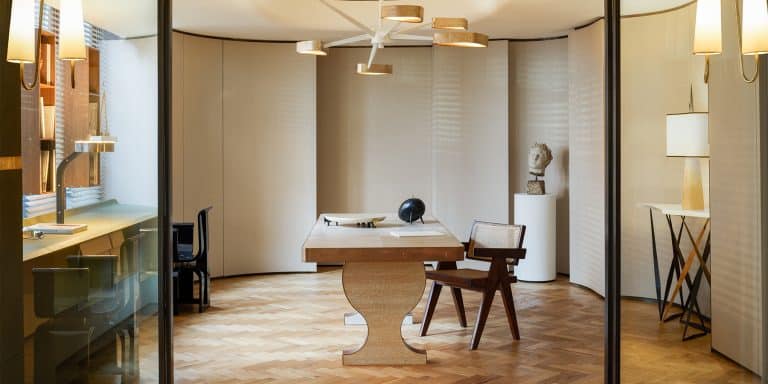
April 10, 2017A selection of vintage rugs curated by textile designer Madeline Weinrib — some of which are seen above at a market in Morocco — is now available on 1stdibs. The granddaughter of the founder of ABC Carpet and a trained painter, Weinrib travels the world frequently on the hunt for prime heirloom pieces, as well as for inspiration for her own contemporary work. Photos courtesy of Madeline Weinrib, unless otherwise noted
Several years ago, when my husband and I purchased an apartment in Palm Beach, we decided that the living room palette would be black and white, accented with a swath of mud cloth from Mali that I’d found on a trip to South Africa, a zebra-print area rug and two graphic throw pillows I’d chanced upon that were designed by Madeline Weinrib, a name I’d never heard of.
A few years later, I had dinner with the jewelry designer Kara Ross. Kara, a tall, striking blonde, was wearing a jacket that looked ancient Asian in its pattern but modern American in its simple cut. I couldn’t stop staring at it. When I asked her who made it, she answered, “Madeline Weinrib.”
The next day I made an appointment to visit Weinrib’s chic and chockablock atelier in New York’s Flatiron District (she also has a showroom in the Design District in San Francisco), and I have been a follower ever since. I bought my own version of Kara’s jacket, which I wear to this day, and was equally tempted by the vintage caftans for sale. Apparel, however, is only a small part of the beautiful offerings I discovered on that first visit. Weinrib is perhaps best known for her carpets, textiles, glassware, bed linens and lacquered boxes, but her trained and discerning eye for style comes through just as strongly, if not more so, in her collection of vintage hand-woven rugs. Now available on 1stdibs, these hail from Turkey, Uzbekistan, Tibet, Morocco, India, Nepal and other far-flung places — irresistible destinations for someone with Weinrib’s visual sensibilities and sense of wanderlust. “I choose them because I think they are beautiful, not for scholarly reasons,” she says. “I like their aesthetic and find them personally appealing.”
Vintage rugs were the last things on Weinrib’s mind when she graduated from Marymount Manhattan College, in New York City. Having majored in art, she wanted to be a painter, full-time and with her own studio. A detour to Rome — where she spent five years off and on, having first gone there to live with a Roman architect — taught her about la bella vita, not least of all about food (“It’s where I learned to cook,” she says), and widened her world.
It’s ironic that Weinrib wasn’t interested in rugs, considering that her grandfather was the founder of ABC Carpet & Home, which is housed in two enduring Manhattan landmarks on opposite corners of 19th Street at Broadway. When her grandfather died, her father inherited and expanded the business. Still, there wasn’t a spark of interest on his daughter’s part. It wasn’t until she began to think about creating carpets in a new way that everything changed. “I went to my father and told him I wanted to try my hand at designing them, as long as I could make whatever I wanted.” Cheeky girl. Nevertheless, Daddy said yes. But first she had to do research, which meant traveling to the places around the world that have the greatest traditions of making hand-woven carpets. Today, she journeys to these spots both to source antique carpets and to work with local artisans who craft her own traditionally inspired contemporary designs.
Exotic places frighten the pants off some people. Too threatening, too unfamiliar, too unbalancing. For Weinrib they have exactly the opposite effect: The more distant and mysterious the location, the more drawn she becomes. Call it geographical pull.
In the case of carpets, geography meant Central Asia, which Weinrib and I talked about during a recent conversation in Palm Beach.

At Weinrib’s beach house in Bridgehampton, on the East End of New York’s Long Island, a vintage Moroccan carpet provides a backdrop for an assemblage of Chesterfield sofas, Barcelona chairs by Mies van der Rohe and a coffee table from R.E. Steele. Photo by Marili Forastieri
What was your first experience in a distant land, and did you take to it right away?
India, for sure. In 1998, I had a two-day stopover in India. I was on my way to Nepal to put together the launch collection of my own rugs for ABC. I well remember being in Delhi and thinking, “If I had to turn around and go home this second, it would have been worth the long trip.” Everything was so exciting — the smells, the noises, the colors.
Why were you heading to Nepal?
I wanted to learn more about the making of hand-woven carpets and spent about ten days there. The carpets I bought in Nepal were actually from Tibet. Tibetans were nomads, so the rugs are usually small and portable. They were used for seating or on the floors of their tents. I regard them as precious throw rugs. I live with them to this day and put them in my home and in my studio. When they were displayed at ABC, there was a sign that read “Do Not Sell.” Imagine that at a retail store!

Weinrib came across this basket of pure indigo during a recent trip to North Africa.
Is it difficult to do business in such far-off places?
The answer is yes, and for lots of reasons, most of them cultural. Then there are climate issues, like monsoons.
What is the easiest place?
Turkey. The minute I get off the plane, I feel at home and different at the same time. As in India, it is the smells, plus Turkey’s beautiful history and the Ottoman designs. My husband, Graham Head, is the chairman of carpets at ABC and knows everything about these designs and was my teacher. It was he who pointed out to me that while the Ottoman Empire was a violent warrior culture, the carpets are actually beautiful, delicate textiles. It’s totally paradoxical.
And the most difficult place in which to do business?
Without question, New York City. It’s a jungle. I’m not kidding.
Central Asia isn’t your only source of inspiration these days.
I adore Morocco — some of my favorite carpets come from there. I was attracted to them from my first trip, in 1999, and go back two or three times a year. Souks and bazaars are happy places for me. I find old Moroccan rugs very painterly, as if they were drawn, not woven. Originally, they weren’t done for commerce. They were made for people’s homes, which feels personal to me.
And I just returned from my third trip to Cartagena, Colombia, where I fell in love with the handicrafts. There is a shop called Casa Chiqui that sells wonderful handwoven baskets. The people are incredibly charming, and the beaches off the coast (not in Cartagena itself) are truly beautiful. I stay at Casablanca, a tiny hotel that I adore and is half the price of the larger ones.
I love Mexico, too, probably because when I was a child, my parents would take me to Acapulco for holidays. Now I am drawn to Ixtapa, even though it is a beach resort. The Capella Ixtapa is where we stay. It’s built on a cliff overlooking the sea.

Weinrib discovered Project Mala on a trip to India in 2000. She’s been supporting the nonprofit ever since, helping it in its work to build schools for and educate children in the country’s carpet-weaving regions.

A vintage Hans Wegner armchair and a chair made of horns, each upholstered in a different Weinrib fabric design, sit on another vintage Moroccan carpet in her Bridgehampton home. Photo by Marili Forastieri
What attracts you to certain places?
I need culture when I travel, so beach resorts are not for me. As far as where I like to stay, I prefer boutique hotels. Most of all, I approach places as an artist. I learned about the world through art history — that is, visually. I am not a weaver. My background is that of a painter. I think it’s an important distinction.
Is there a place that beckons you?
Spain! That might be my next trip. I’d love to see the mosque in Córdoba, which is now a Catholic cathedral, and all the Moorish architecture in southern Spain. Architecture inspires me, so I know I’d be moved by the works by Antoni Gaudí in Barcelona.
Are there any museums that have permanent textile or rug collections?
I can think of two right away: the Topkapi Palace Museum, in Istanbul, which was the sultan’s residence during the Ottoman reign, and the Calico Museum in Ahmedabad, in the Indian state of Gujarat, with its ancient Mogul textiles.
What are your expansion plans?
I don’t want to expand. I’m trying hard to stay small and artisanal. It’s not easy in the world in which we live. I am about authenticity and am averse to mass production and copying. That’s why I love working with artisans and giving them a chance to create my products.
Do you ever meet resistance from artisans when you ask them, for example, to work in ways that are not familiar to them?
Artisanship is an important part of my work. It’s how my own designs started. I studied traditional methods and looked at what these craftspeople were doing. But we all have our ideas about beauty. In India and in parts of Central Asia, color is part of the culture. So if I ask that a traditional print be in stark black and white, it is often an adjustment.
Today, many products can be made easily by machines, but I remain dedicated to what can be done by hand and have a deep commitment to help the artisans I work with.

The motifs on Moroccan doors have long inspired Weinrib’s own designs.
Do you work with a translator?
Almost always. It’s usually necessary.
With all your travel, you must have found ways to deal with jet lag.
Jet lag is tough. As soon as I arrive, I take a twenty-minute bath and continue to do so every day while I’m away. It helps with dehydration. I wash my hands a lot, carry sanitizing wipes and drink lots of water, especially on the flights. I always avoid alcohol while flying.
What about food?
I’m careful. I’ve gotten sick when I wasn’t, and it was terrible. Sometimes, I will say I’m a vegetarian, even though I’m not, just to be on the safe side. Still, food is a big draw for me wherever I travel.
What about how you dress?
I try not to draw attention to myself as a Western woman. For instance, I cover my arms and never wear anything that is revealing — out of respect, which greatly eases the way in such unfamiliar cultures.
